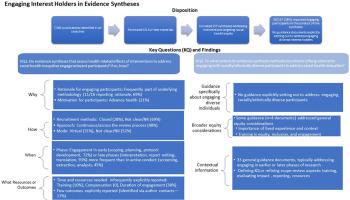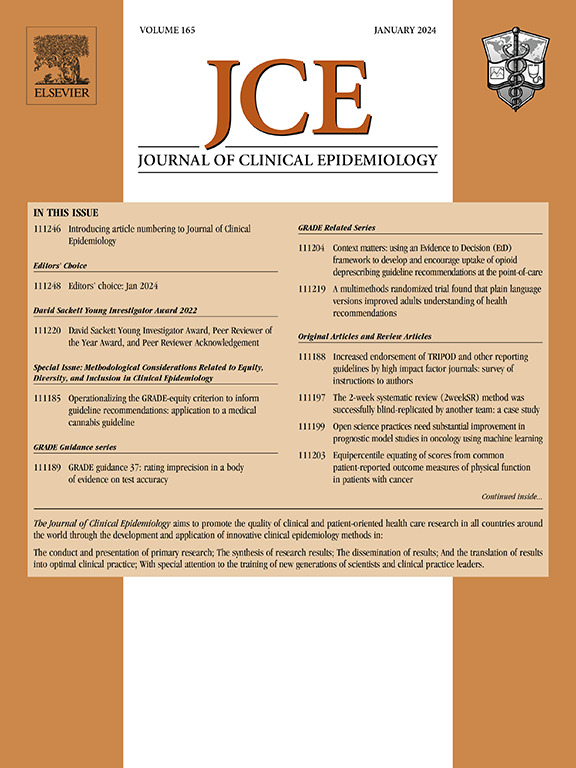Centering racial health equity in systematic reviews paper 6: engaging racially and ethnically diverse interest holders in evidence syntheses
IF 7.3
2区 医学
Q1 HEALTH CARE SCIENCES & SERVICES
引用次数: 0
Abstract
Objectives
To inform methods for centering racial health equity in syntheses, we explored (1) how syntheses that assess health-related interventions and explicitly address racial health inequities have engaged interest holders and (2) guidance for engaging racially and ethnically diverse interest holders.
Study Design and Setting
We systematically identified evidence syntheses (searches limited to January 1, 2020, through January 25, 2023) and guidance documents (no search date limits) for this overview. From syntheses we extracted data on engagement rationale and processes and extracted approaches suggested from guidance documents. We summarized findings qualitatively.
Results
Twenty-nine of the 157 (18%) eligible syntheses reported using engagement. Syntheses typically lacked robust detail on why and how to use and structure engagement and outcomes/effects of engagement, though syntheses involving Indigenous populations typically included more detail. When reported, engagement typically occurred in early and later synthesis phases. We did not identify guidance documents that specifically intended to provide guidance for engaging racially/ethnically diverse individuals in syntheses; some related guidance described broader equity considerations or engagement in general.
Conclusion
This review highlights gaps in understanding of the use of engagement in racial health equity-focused syntheses and in guidance specifically addressing engaging racially and ethnically diverse populations. Syntheses and guidance materials we identified reported limited data addressing the whys, hows, and whats (ie, rationale for, approaches to, resources needed and effects of) of engagement, and we lack information for understanding whether engagement makes a difference to the conduct and findings of syntheses and when and how engagement of specific populations may contribute to centering racial health equity. A more informed understanding of these issues, facilitated by prospective and retrospective descriptions of engagement of diverse interest holders, may help advance actionable guidance and reviews.
Plain Language Summary
We identified evidence syntheses (a kind of research that identifies and summarizes findings of individual studies or publications to address research questions) that looked at studies of interventions to improve differences in effects on health for racial or ethnic populations to see (1) if and how they incorporated perspectives of interest holders, people with an interest in the subject being studied; (2) what guidance for how to engage or involve racially or ethnically diverse interest holders exists. We found that 29 of 157 syntheses addressing interventions to improve differences in effects on health reported involving interest holders but typically did not provide much detail about how to involve people. Syntheses that involved Indigenous people usually had more information, but overall, the syntheses did not have much information about how to involve people and what the impact of involving them may be. We did not find guidance information that specifically set out to provide information about engaging racially/ethnically diverse individuals in syntheses; some related guidance described considerations about involving people in syntheses in general. This review highlights gaps in understanding of how to engage people in racial health equity-focused syntheses and in guidance specifically addressing engaging racially and ethnically diverse populations. Syntheses and guidance materials we identified reported limited information about whys, hows, and whats (ie, reasons to use, how to do, and resources needed and effects of) related to engagement, and we lack information to help understand whether engagement makes a difference in doing syntheses and when and how engagement of specific populations may help to address racial health equity.

以系统综述中的种族健康公平为中心 文件 6:让不同种族和族裔的利益相关者参与证据综述。
目的:为了告知在综述中以种族健康公平为中心的方法,我们探讨了:1)评估健康相关干预措施并明确解决种族健康不公平问题的综述如何吸引利益相关者的参与;2)吸引种族和民族多元化利益相关者参与的指导:我们为本综述系统地确定了证据综述(搜索仅限于 2020 年 1 月 1 日至 2023 年 1 月 25 日)和指导文件(无搜索日期限制)。我们从综述中提取了有关参与理由和过程的数据,并从指导文件中提取了建议的方法。我们对研究结果进行了定性总结:在符合条件的 157 篇综述中,有 29 篇(18%)报告了参与的情况。尽管涉及土著居民的综述通常包含更多细节,但这些综述通常缺乏关于为什么、如何使用和组织参与以及参与的结果/影响的有力细节。如果报告了参与情况,参与通常发生在早期和后期的综合阶段。我们没有发现专门为种族/族裔不同的个人参与综述提供指导的指导文件;一些相关的指导文件描述了更广泛的公平考虑因素或一般性参与:本综述强调了在以种族健康公平为重点的综述中使用参与的理解方面,以及在专门针对种族和民族多元化人群参与的指导方面存在的差距。我们确定的综述和指导材料报告了有限的数据,这些数据涉及参与的原因、方式和内容(即参与的理由、方式、所需资源和效果),我们缺乏信息来了解参与是否会对综述的进行和结果产生影响,以及何时和如何让特定人群参与可能有助于种族健康公平中心化。通过对不同利益相关者参与情况的前瞻性和回顾性描述,我们可以对这些问题有更深入的了解,这将有助于推进可操作的指导和审查。
本文章由计算机程序翻译,如有差异,请以英文原文为准。
求助全文
约1分钟内获得全文
求助全文
来源期刊

Journal of Clinical Epidemiology
医学-公共卫生、环境卫生与职业卫生
CiteScore
12.00
自引率
6.90%
发文量
320
审稿时长
44 days
期刊介绍:
The Journal of Clinical Epidemiology strives to enhance the quality of clinical and patient-oriented healthcare research by advancing and applying innovative methods in conducting, presenting, synthesizing, disseminating, and translating research results into optimal clinical practice. Special emphasis is placed on training new generations of scientists and clinical practice leaders.
 求助内容:
求助内容: 应助结果提醒方式:
应助结果提醒方式:


